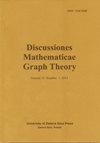非星树的拉姆齐数与六阶连通图的比较
IF 0.8
4区 数学
Q3 MATHEMATICS
引用次数: 2
摘要
本文完成了n阶树Tn和6阶连通图G的拉姆齐数r(Tn, G)的研究。如果χ(G)≥4,则r(Tn, G)的值对于任意树Tn都是已知的。此外,我们还研究了χ(G)≤3时r(Sn, G),其中Sn为n阶星。如果χ(G) = 3且g6 = K2,2,2,则r(Sn, G)已经确定,除了一些G和一些较小的n。对于r(Sn,K2,2,2)和r(Sn, G) (χ(G) = 2)已获得部分结果。本文研究了非星树n和χ(G)≤3的r(Tn, G)。特别是,如果χ(G) = 3,其中g6 = K2,2,2, r(Tn,K2,2,2)对于最大度较小的一类树Tn是确定的,则r(Tn,K2,2,2)对于任何非星树Tn是完全求值的。在χ(G) = 2的情况下,研究了n阶路径Tn = Pn的r(Tn, G),以及n阶路径Tn = B2,n−2的r(Tn, G),通过识别具有路径Pn−2端点的星S3的中心而得到的n阶特殊扫帚。此外,对于n≥m−1的所有n和m, r(B2,n−2,Sm)的值都确定。作为本文的结果,r(F,G)对于所有最多5阶的树F和所有最多6阶的连通图G是已知的。本文章由计算机程序翻译,如有差异,请以英文原文为准。
On the Ramsey numbers of non-star trees versus connected graphs of order six
This paper completes our studies on the Ramsey number r(Tn, G) for trees Tn of order n and connected graphs G of order six. If χ(G) ≥ 4, then the values of r(Tn, G) are already known for any tree Tn. Moreover, r(Sn, G), where Sn denotes the star of order n, has been investigated in case of χ(G) ≤ 3. If χ(G) = 3 and G 6= K2,2,2, then r(Sn, G) has been determined except for some G and some small n. Partial results have been obtained for r(Sn,K2,2,2) and for r(Sn, G) with χ(G) = 2. In the present paper we investigate r(Tn, G) for non-star trees Tn and χ(G) ≤ 3. Especially, r(Tn, G) is completely evaluated for any non-star tree Tn if χ(G) = 3 where G 6= K2,2,2, and r(Tn,K2,2,2) is determined for a class of trees Tn with small maximum degree. In case of χ(G) = 2, r(Tn, G) is investigated for Tn = Pn, the path of order n, and for Tn = B2,n−2, the special broom of order n obtained by identifying the centre of a star S3 with an end-vertex of a path Pn−2. Furthermore, the values of r(B2,n−2, Sm) are determined for all n and m with n ≥ m− 1. As a consequence of this paper, r(F,G) is known for all trees F of order at most five and all connected graphs G of order at most six.
求助全文
通过发布文献求助,成功后即可免费获取论文全文。
去求助
来源期刊

Discussiones Mathematicae Graph Theory
MATHEMATICS-
CiteScore
2.20
自引率
0.00%
发文量
22
审稿时长
53 weeks
期刊介绍:
The Discussiones Mathematicae Graph Theory publishes high-quality refereed original papers. Occasionally, very authoritative expository survey articles and notes of exceptional value can be published. The journal is mainly devoted to the following topics in Graph Theory: colourings, partitions (general colourings), hereditary properties, independence and domination, structures in graphs (sets, paths, cycles, etc.), local properties, products of graphs as well as graph algorithms related to these topics.
 求助内容:
求助内容: 应助结果提醒方式:
应助结果提醒方式:


